The future of Earth observation, Part III
This post is a part of a series on the future of earth observation, and is a follow up to The Future of Optical Earth Observation I: The road so far and The Future of Earth Observation II: What do users really want, anyway?
Originally, satellite imagery consisted of just that: images. However, there is limited information in a static snapshot of a scene. The sense of depth, in particular, is lacking. This can be compensated by taking two images of the same scene from different points of views, to get a 3D representation the same way our two eyes are used two build a 3D representation of the world.
But why stop at only two images? Our eyes do not, and continuously capture images, enabling us to see the motion of objects, and extract meaningful information out of this motion. Satellites can do the same, by acquiring images in quick succession:
These videos were captured by the SkySat satellite from Terra Bella (formerly Skybox), and show the kind of information that video from space can add to static imagery. They have a high framerate: the time between consecutive images is short enough that our eyes see continuous movement. This time can be increased, making the movement choppy but still exploitable, like in this pléiades timelapse.
LEO limitations
Unfortunately, this kind of video cannot last very long: due to the movement of low earth orbit (LEO) satellites, they move in and out of sight of a given location in a few minutes. This movement can be seen in the changing parallax of the pléiades video: the angle of the building changes as the satellite passes over them. Thus, the persistency (the duration of available video) offered by the low-orbit satellites is limited.

Moreover, the video is not available on-demand: the satellite has to pass over the location to be imaged, and due to orbital mechanics, this can take hours or days. To get a second video later, the satellite has to revisit the place, which also takes hours to days. So revisit, the time between two possible video acquisitions, is very important. Typically a constellation of two agile LEO satellites on a 700km orbit can provide daily revisit for places at the equator
User needs
So standard LEO satellites have serious persistency and revisit limitations, which is an issue since some users would like to be able to watch any place continuously, 24/7, in a drone-like fashion. For instance, for crisis management (see The Future of Earth Observation II), a short revisit is needed. The applications enabled by different levels of persistency and revisit are summarized in the graph below:
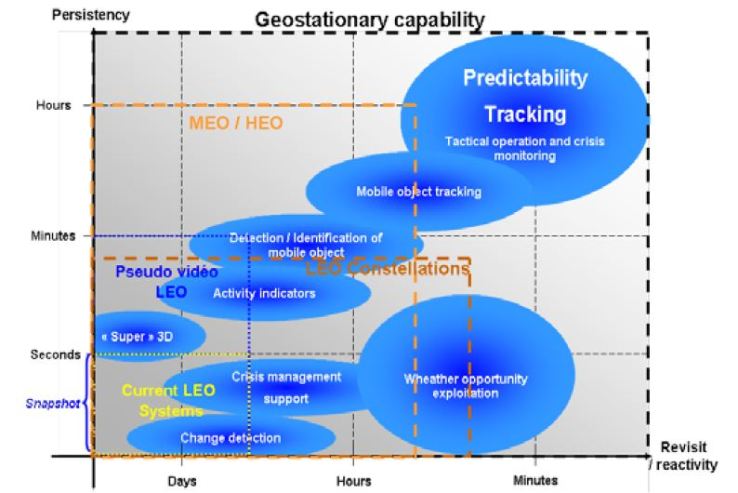
Mobile object tracking and tactical operations monitoring are especially interesting for military users: Since knowing is half the battle, having the precise position of enemy ships and planes is a significant advantage. For ground operations, constant monitoring has proven its value through the widespread use of drones in recent American wars and occupations. Several projects on the use of drones for wide-area persistent surveillance are in active development or in use. However, drones cannot be everywhere nor be deployed instantly, and using them in a foreign airspace can cause diplomatic problems, whereas a satellite solution does not violate any borders and ideally could watch everywhere all the time. The strategic intelligence gains provided by constant monitoring are also significant: it ensures that no interesting activity is missed.
Since military and intelligence applications are promising and the corresponding budgets can be generous, a potential market for high-persistency, high-revisit satellite imaging exists provided the cost of such a system can be kept reasonably low. The problem is there is a hard tradeoff to be made between the number of satellites of the system and their complexity: doing it with LEO satellites requires a lot of relatively simple satellites, because each satellite offer poor revisit and persistency on its own. Doing it with satellites on higher orbits requires fewer, but much more complex satellites. This is because there is a direct relationship between the altitude of a satellite and the persistency it provides: the higher the orbit, the longer the persistency.

Technical solutions
There are three ways to solve this tradeoff: a constellation of tens of LEO satellites, which will be treated in a later post, a few satellites in Medium Earth Orbit (MEO), or one to three satellites in Geostationary orbit (GEO)
MEO constellation
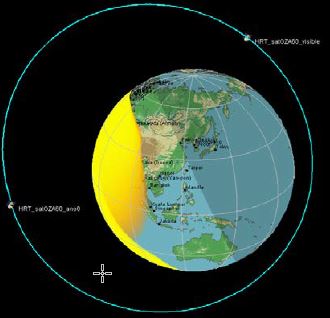
Since persistency is limited by the orbital altitude, the first thing to do to expand it is to increase the altitude. This can be done using elliptical orbits with apogees up to 6000km, as shown in the picture above. Because the orbit is elliptical, the satellite has a lower speed at apogee, and thus hangs around it for a longer period of time compared to a circular orbit.
Increasing the orbit raises three issues: first, the size of the satellite’s telescope, specifically the diameter of its primary mirror, has to be increased proportionally to altitude in order to keep the same resolution. For a 6000km orbits, this is roughly a 10x increase compared to a LEO satellite. This increase in size translates in an even bigger quadratic increase in mirror mass: mirror mass depends on the area of the mirror, so a 10x increase in diameter results in a 100x increase in mirror mass if the same technology is used. The mass of the mirror is such an important point for high-resolution optical satellites that there is a constant research effort on the use of lightweight materials and lightweight structures for mirrors.
The second problem with MEO orbits is radiation: Earth’s magnetic field traps radiation, and at 6000km this radiation is much more intense than in LEO. Finally, the third issue with high elliptical orbits is that they require more energy to be reached than LEO. This limits the mass a rocket can inject in such an orbit.
Interestingly, there has been at least one MEO satellite program that has reached orbit: the Russian Araks program. A first satellite was launched in 1997 and failed quickly after reaching orbit, a second in 2002 failed after one year. The third was not even launched. The satellites sported a 1.5m mirror, probably able to produce 1.3m imagery from the satellite’s 2800km x 1500km orbit. Araks was supposed to be complemented by the Sapfir project, on a 10 000- 20 000km orbit.
The USA is speculated to have thought about MEO satellites then dropped the idea. The leaked 2013 intelligence budget documents do not mention any high-orbit electro-optical satellites.
In France, Thales Alenia Space and Airbus have studied the question. Airbus in particular did architecture studies on a HRT (High Temporal Resolution) project, consisting of one or two satellites on an elliptical orbit with a 6500km apogee. This would grant 30 to 45 minutes of persistency per satellite, and a revisit of 3h with one and 1h30 with two. With four satellites, the system would be able to provide continuous coverage during roughly 6 hours each day. The satellites would use 3m mirrors, giving a resolution of 1.5m. A 5m mirror, as large as the largest fairings of commercial rockets, would provide a resolution just under 1m.
Overall, Medium Earth Orbit systems are interesting because they offer significant persistency for a moderate technical risk. They can provide exploitable resolution using reasonably large mirrors that can be launched in one piece, without any complicated deployment mechanism. Such 2 to 3m mirrors are already manufactured or planned to be manufactured by the USA, Russia and China, so no optics breakthrough are needed for them, and they could decide to launch such systems relatively quickly.
Geostationary orbit
Since the persistency offered by MEO orbits is high but still not round-the-clock, there is only one solution to get full persistency: putting the satellites in geostationary orbit (GEO), 36 000km away from Earth. From the ground, objects in this orbit appear to be fixed in the sky because they follow the rotation of the Earth. Thus, a GEO satellite can stay pointed a given location 24 hours a day, every day of the year. This feature is used by communication satellites to provide uninterrupted communications. It can also be used by imaging satellites: for instance, GEO weather satellites provide images of the whole Earth disk every 30 minutes or less, in order to be able to see cloud movement.
Weather satellites typically have spatial resolution in the hundreds of meters, far too low to be useful for surveillance. But a GEO satellite with a big enough telescope could provide truly persistent surveillance with high enough resolution. The question is, how big of a telescope is needed? As can be seen in the graph below, the answer is “really big”:

The graph reads as follows: a 1m diameter telescope provides a 20m ground resolution. It can also be read the other way around: a 20m telescope provides 1m resolution. So extremely large telescopes are needed to reach high resolution. For comparison, the largest ground telescope currently only has a diameter of 10.4m, and ground telescopes will not reach 20m before the early 2020s. The largest mirror ever launched in space is to public knowledge the Herschel space telescope, with a diameter of 3.5m. The James Webb space telescope will only reach 6.5m, after years and billions of dollars of development.
Consequently, because GEO is much further than MEO, much bigger mirrors are required for the same job, and the technology is not there yet to build metric-resolution systems. However, lower resolution systems can already be useful: for instance, China has launched the Gaofen-4 satellite. From GEO, its provides 50m resolution visible light images, and 400m resolution infrared images. This is enough to detect large ships, as can be seen in the images below, and probably to classify them by type, thanks to the persistency of the imagery:
50m resolution only requires a 0.4m mirror, which is very reasonable and can fit on a standard geostationary platform. India is also building a 50m-resolution GEO satellite called GISAT-1, scheduled to launch in 2017. GISAT-1 will even have hyperspectral capabilities, to be better able to identify the content of each pixel in spite of the low resolution.
In the USA, the DSP missile early-warning satellites located GEO since 1970 eventually became able to detect large aircrafts on afterburner, and passed this information to the Navy in near real-time. These satellites use low-resolution thermal infrared sensors, with very low resolution (probably around 1km). However, even with this low resolution, they can provide interesting real-time intelligence: for instance they can also detect aircraft crashes, and the afterbuner use mentioned above. The follow-on SBIRS program improves on these capabilities (denominated SLOW WALKER) and might even detect tactical missiles and artillery explosions.
European industry has also been working on the subject. ESA and Airbus have a design called GEO-oculus, able to provide 13m resolution thanks to a 1.5m mirror. Airbus also has a design called GO-3S (for Geostationary Observation Space Surveillance System), with a 4m mirror. Airbus advertises a 100km x 100km field of view, with a 5 frames per second refresh rate and 3m resolution, although by traditional measures the resolution would be around 5m. The high frame rate combined with the moderate resolution enables the detection of moving objects such as cars, with a high probability of detection, even if they are smaller than the ground resolution:
Additional GO-3S videos can be found there and there. Due to current launcher mass and fairings constraints, 4m to 5m mirrors is the largest size that can be launched to GEO while keeping a traditional mirror made of a single piece of glass, which makes the satellite relatively simple and affordable. Bigger mirrors require breakthrough beyond the current sate of the art.
The path to large optics
One way overcome the limits of fairing size is to split up the main mirror into several smaller mirrors and fold them inside the rocket fairing so that it fits. After launch, the system unfolds, the mirrors are then aligned with sub-micron precision, and function together in the same way as a single-piece telescope of roughly the same size. This is the solution used in the James Webb Space Telescope (JWST) to reach the required 6.5m mirror size while still fitting inside a 5m-diameter Ariane 5 fairing.
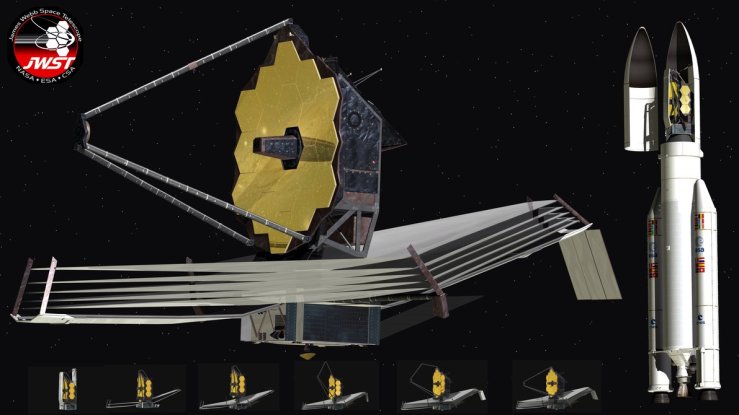
This segmented-optics solution is extremely expensive: the JWST is scheduled to cost 8 billion US dollars and has been in development for more than ten years. However, it does not operate on visible light: a visible-light equivalent of the JWST requires an even finer alignment of the mirrors, pushing the technology even more. But is not impossible: the NRO has developed a 3m segmented telescope prototype, the Segmented Mirror Telescope, and made its existence public in 2010.
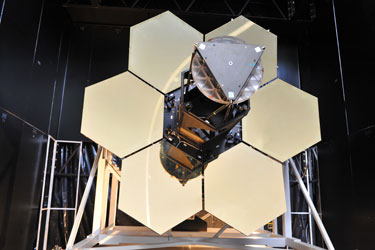
To reach larger diameters, more exotic configuration are required, such as this multiple-mirror concept by Thales, presented at the 2010 ESA High Resolution GEO imaging workshop:
However, the complexity and the remaining mass and packaging constraints of deployable mirrors make them a highly risky solution for large mirrors in the 10-20m range. So other technologies have to be explored. Enter MOIRE, a DARPA program contracted to Ball Aerospace, to study a game-changing optical solution. MOIRE stands for Membrane Optical Imager (for) Real-time Exploitation, and studied the use of a thin membrane to form images. This technology promises a 7x reduction in mass and 10x in cost compared to rigid mirrors, and makes diameters of 10m to 20m realistically achievable. Ball successively demonstrated ground operation of a small-scale model. China is also working on this technology, with similar objectives.


Finally, a solution might come with the introduction of new rockets with larger fairings in the coming years, if they do reach the launchpad: SLS block 2 will have a 10m fairing, the New Glenn rocket from Blue Origin a 7m one, and the 2017 version of the SpaceX BFR/Interplanetary Transport System is designed with a 9m diameter. Large fairings can be combined with other solutions: NASA is studying a 12m-diameter segmented mirror telescope launched by the SLS block II as a potential Hubble successor.


Conclusion
Overall, the geostationary orbit provides an interesting persistent surveillance capability, but only at moderate resolution in the near term. For higher resolutions, medium Earth orbit offers a good mix of persistency and image quality, while low Earth orbit promises high revisit rates with simple satellites, as we will see in the next post of this series.









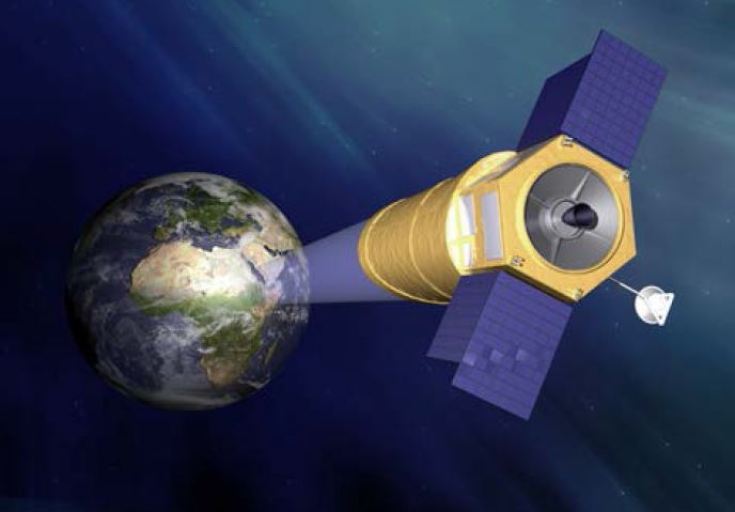


[…] very, very far away. But they have the advantage of what we call persistence, allowing satellites to capture images continuously. In those orbits, you’re essentially overlooking the exact same piece of ground on the Earth’s […]
LikeLike
[…] very, very far away. But they have the advantage of what we call persistence, allowing satellites to capture images continuously. In those orbits, you’re essentially overlooking the exact same piece of ground on the Earth’s […]
LikeLike
[…] very, very far away. But they have the advantage of what we call persistence, allowing satellites to capture images continuously. In those orbits, you’re essentially overlooking the exact same piece of ground on the Earth’s […]
LikeLike
[…] very, very far away. But they have the advantage of what we call persistence, allowing satellites to capture images continuously. In those orbits, you’re essentially overlooking the exact same piece of ground on the Earth’s […]
LikeLike
[…] very, very far away. But they have the advantage of what we call persistence, allowing satellites to capture images continuously. In those orbits, you’re essentially overlooking the exact same piece of ground on the Earth’s […]
LikeLike
[…] The second type of satellite orbit is called geosynchronous orbit, and that’s much farther away. It has the disadvantage that it’s harder to see things clearly when you’re very, very far away. But they have the advantage of what we call persistence, allowing satellites to capture images continuously. […]
LikeLike
[…] very, very far away. But they have the advantage of what we call persistence, allowing satellites to capture images continuously. In those orbits, you’re essentially overlooking the exact same piece of ground on the Earth’s […]
LikeLike
[…] very, very far away. But they have the advantage of what we call persistence, allowing satellites to capture images continuously. […]
LikeLike
[…] The second type of satellite orbit is called geosynchronous orbit, and that’s much farther away. It has the disadvantage that it’s harder to see things clearly when you’re very, very far away. But they have the advantage of what we call persistence, allowing satellites to capture images continuously. […]
LikeLike
[…] Pero tienen la ventaja de lo que llamamos persistencia, lo que permite a los satélites capturar imágenes continuamente. […]
LikeLike
[…] very distant. However they’ve the benefit of what we name persistence, permitting satellites to capture images continuously. In these orbits, you’re primarily overlooking the very same piece of floor on the Earth’s […]
LikeLike
[…] very, very far away. But they have the advantage of what we call persistence, allowing satellites to capture images continuously. In those orbits, you’re essentially overlooking the exact same piece of ground on the Earth’s […]
LikeLike
[…] very, very far away. But they have the advantage of what we call persistence, allowing satellites to capture images continuously. In those orbits, you’re essentially overlooking the exact same piece of ground on the Earth’s […]
LikeLike
[…] very, very far away. But they have the advantage of what we call persistence, allowing satellites to capture images continuously. In those orbits, you’re essentially overlooking the exact same piece of ground on the Earth’s […]
LikeLike
[…] very, very far away. But they have the advantage of what we call persistence, allowing satellites to capture images continuously. In those orbits, you’re essentially overlooking the exact same piece of ground on the Earth’s […]
LikeLike
[…] very, very far away. But they have the advantage of what we call persistence, allowing satellites to capture images continuously. In those orbits, you’re essentially overlooking the exact same piece of ground on the Earth’s […]
LikeLike
[…] very, very far away. But they have the advantage of what we call persistence, allowing satellites to capture images continuously. In those orbits, you’re essentially overlooking the exact same piece of ground on the Earth’s […]
LikeLike
[…] very, very far away. But they have the advantage of what we call persistence, allowing satellites to capture images continuously. In those orbits, you’re essentially overlooking the exact same piece of ground on the Earth’s […]
LikeLike
[…] very, very far away. But they have the advantage of what we call persistence, allowing satellites to capture images continuously. In those orbits, you’re essentially overlooking the exact same piece of ground on the Earth’s […]
LikeLike
[…] very, very far away. But they have the advantage of what we call persistence, allowing satellites to capture images continuously. In those orbits, you’re essentially overlooking the exact same piece of ground on the Earth’s […]
LikeLike
[…] very, very far away. But they have the advantage of what we call persistence, allowing satellites to capture images continuously. In those orbits, you’re essentially overlooking the exact same piece of ground on the Earth’s […]
LikeLike
[…] very far-off. However they’ve the benefit of what we name persistence, permitting satellites to seize steady photographs. In these orbits, you are primarily watching the very same piece of floor on Earth’s floor on […]
LikeLike
[…] very, very far away. But they have the advantage we call persistence, which allows satellites Take pictures continuously. In those orbits, you’re essentially always observing exactly the same portion of the […]
LikeLike
[…] very, very far away. But they have the advantage of what we call persistence, allowing satellites to capture images continuously. In those orbits, you’re essentially overlooking the exact same piece of ground on the Earth’s […]
LikeLike
[…] very, very far away. But they have the advantage of what we call persistence, allowing satellites to capture images continuously. In those orbits, you’re essentially overlooking the exact same piece of ground on the Earth’s […]
LikeLike
[…] very distant. But they’ve the benefit of what we name persistence, permitting satellites to seize photographs constantly. In these orbits, you’re primarily overlooking the very same piece of floor on the Earth’s […]
LikeLike
[…] very, very far away. But they have the advantage of what we call persistence, allowing satellites to capture images continuously. In those orbits, you’re essentially overlooking the exact same piece of ground on the Earth’s […]
LikeLike
[…] very far-off. However they’ve the benefit of what we name persistence, permitting satellites to capture images continuously. In these orbits, you’re basically overlooking the very same piece of floor on the Earth’s […]
LikeLike
[…] very, very far away. But they have the advantage of what we call persistence, allowing satellites to capture images continuously. In those orbits, you’re essentially overlooking the exact same piece of ground on the Earth’s […]
LikeLike
[…] very, very far away. But they have the advantage of what we call persistence, allowing satellites to capture images continuously. In those orbits, you’re essentially overlooking the exact same piece of ground on the Earth’s […]
LikeLike
[…] very far-off. However they’ve the benefit of what we name persistence, permitting satellites to capture images continuously. In these orbits, you’re primarily overlooking the very same piece of floor on the Earth’s […]
LikeLike
[…] very, very far away. But they have the advantage we call persistence, which allows satellites Take pictures continuously. In those orbits, you’re essentially always observing exactly the same piece of land on […]
LikeLike
[…] very far away. But they have the advantage of what we call persistence, allowing satellites to capture images continuously. In those orbits, you’re essentially overlooking the exact same piece of ground on the Earth’s […]
LikeLike
[…] very, very far away. But they have the advantage of what we call persistence, allowing satellites to capture images continuously. In those orbits, you’re essentially overlooking the exact same piece of ground on the Earth’s […]
LikeLike
[…] con claridad. Pero tienen la ventaja de lo que llamamos persistencia, que permite a los satélites captar imágenes continuamente. En esas órbitas, siempre se ve exactamente la misma zona de la superficie terrestre porque el […]
LikeLike
[…] very, very far away. But they have the advantage of what we call persistence, allowing satellites to capture images continuously. In those orbits, you’re essentially overlooking the exact same piece of ground on the Earth’s […]
LikeLike
[…] very, very far away. But they have the advantage of what we call persistence, allowing satellites to capture images continuously. In those orbits, you’re essentially overlooking the exact same piece of ground on the Earth’s […]
LikeLike
[…] claridad. Pero tienen la ventaja de lo que llamamos persistencia, que permite a los satélites captar imágenes continuamente. En esas órbitas, siempre se ve exactamente la misma zona de la superficie terrestre porque el […]
LikeLike
[…] The second type of satellite orbit is called geosynchronous orbit, and that’s much farther away. It has the disadvantage that it’s harder to see things clearly when you’re very, very far away. But they have the advantage of what we call persistence, allowing satellites to capture images continuously. […]
LikeLike
[…] very, very far away. But they have the advantage of what we call persistence, allowing satellites to capture images continuously. In those orbits, you’re essentially overlooking the exact same piece of ground on the Earth’s […]
LikeLike
[…] very, very far away. But they have the advantage of what we call persistence, allowing satellites to capture images continuously. In those orbits, you’re essentially overlooking the exact same piece of ground on the Earth’s […]
LikeLike
[…] very far-off. However they’ve the benefit of what we name persistence, permitting satellites to seize photos repeatedly. In these orbits, you’re primarily overlooking the very same piece of floor on the Earth’s […]
LikeLike
[…] The second type of satellite orbit is called geosynchronous orbit, and that’s much farther away. It has the disadvantage that it’s harder to see things clearly when you’re very, very far away. But they have the advantage of what we call persistence, allowing satellites to capture images continuously. […]
LikeLike
[…] very, very far away. But they have the advantage of what we call persistence, allowing satellites to capture images continuously. In those orbits, you’re essentially overlooking the exact same piece of ground on the Earth’s […]
LikeLike
[…] away. However they’ve the good thing about what we name patience, permitting satellites to seize photographs regularly. In the ones orbits, you’re necessarily overlooking the very same piece of flooring at the […]
LikeLike